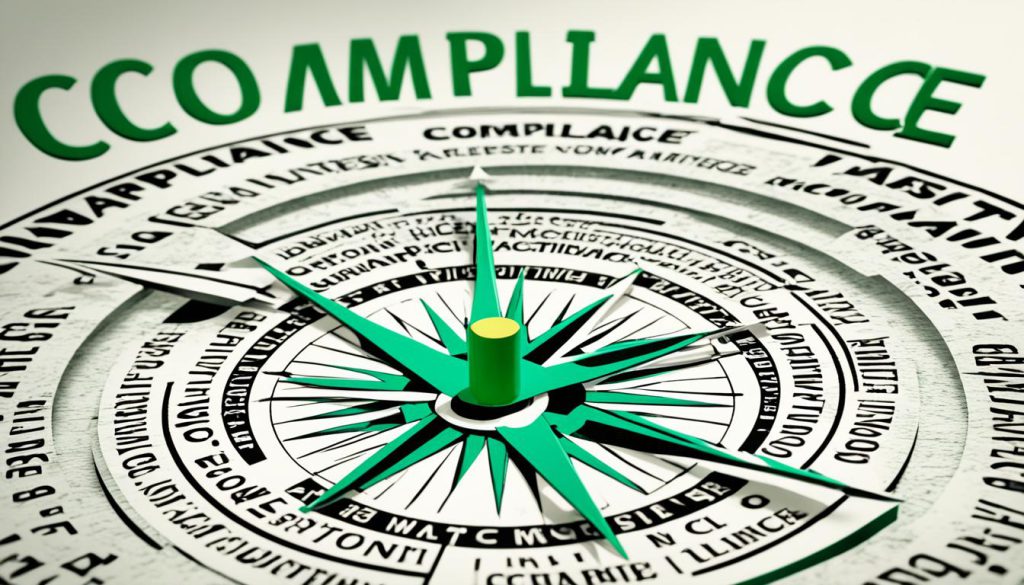Did you know the US has over 430,000 federal regulations? That’s a huge number of rules stretching across libraries worth of texts. This makes navigating the regulatory environment tough for businesses.
Yet, knowing and following these regulations is crucial. It helps avoid fines, keeps you legally compliant, and ensures you operate correctly.
We made this guide to help simplify US regulations. It’s great for anyone just starting or looking to better their compliance. This guide gives you knowledge and tools for staying on top of regulations, being current with changes, and handling common issues.
Key Takeaways:
- US regulations are complex and extensive, with over 430,000 federal regulations.
- Navigating regulations is crucial for businesses to avoid penalties and maintain legal compliance.
- This guide will provide comprehensive insights on understanding, identifying, and complying with regulations.
- It will also address common challenges businesses face and offer strategies for overcoming them.
- By following the guidelines in this guide, businesses can ensure they operate within the regulatory framework and stay compliant.
Understanding and Identifying Regulations
It’s very important for businesses to really get how regulations work. This helps them stay in line with the law. Talking about regulatory compliance, we’ll look into various types that affect businesses. Knowing these helps businesses deal with legal needs wisely.
The Importance of Regulatory Compliance
Regulations are rules set by authorities to make sure businesses do right by everyone. They ensure companies act ethically and are good for customers and society. Being compliant means sticking to these rules and laws.
When businesses follow these rules, they avoid big troubles like fines or losing their good name. Plus, it builds trust with everyone important, like customers and the government.
Types of Regulations
Different industries face different rules. Here’s a look at some:
- Environmental regulations: These make sure businesses are kind to nature, reducing harm and being sustainable.
- Financial regulations: Aimed at the finance world, they try to keep things stable, prevent cheating, and protect the people using these services.
- Employment regulations: These focus on treating workers fairly, keeping them safe, and making sure everyone has equal chances at jobs.
- Privacy regulations: These are about keeping personal info safe and making sure companies handle it the right way.
- Industry-specific regulations: Each type of work might have its own rules for special issues and needs.
Identifying Applicable Regulations
Finding out what rules your business needs to follow is key. You’ve got to do your homework, ask the pros, and keep up with news. Here are steps to figure out your specific rules:
- Research: Start by digging into the rules for your kind of business. Look for special rules and which government offices manage them.
- Consult experts: Get advice from lawyers, groups, or consultants who know your industry well. They can point out the exact rules you should follow.
- Engage in industry dialogue: Join in on talks and meetings to learn about new or changing rules. It helps to know what’s coming.
- Monitor regulatory changes: Always check updates in the news or from professional sources so you’re never caught off guard by new rules.
Getting a handle on the rules that apply to you helps create a plan. This plan keeps your business lawful and running smoothly.

| Benefits of Regulatory Compliance | Challenges of Regulatory Compliance |
|---|---|
| 1. Avoid legal consequences | 1. Keeping up with ever-changing regulations |
| 2. Enhance trust and credibility | 2. Balancing compliance with business operations |
| 3. Improve operational efficiency | 3. Managing the cost of compliance |
| 4. Mitigate business risks | 4. Ensuring employee awareness and training |
| 5. Foster a culture of integrity | 5. Dealing with regulatory inspections and audits |
Navigating Regulatory Changes
Today’s business world is always changing, especially with regulations. Being compliant with these changes is vital for your company’s success. To handle these effectively, a strong compliance framework is key.
A compliance framework helps manage regulatory needs. It makes sure your business practices are up to date. This involves creating and following policies, procedures, and controls.
This framework lets your business adjust fast to regulatory changes. It lowers the risk of not following these changes. It helps spot what needs to change to meet new regulations.
Staying Informed and Implementing Seamless Changes
To stay on top of regulatory changes, you must be well-informed. Keep an eye on updates in your field and beyond. Watching for new regulations, reading industry news, and joining industry groups are good steps. Technology and news platforms can also offer immediate updates.
When bringing in regulatory changes, planning is crucial. Start with assessing how the changes will impact your business. Inform everyone involved and outline clear steps for a smooth changeover.
“Embracing regulatory changes as opportunities for growth and improvement is key to surviving and thriving in today’s business landscape.”
By adding regulatory changes into your compliance framework, your organization stays flexible and ready for the future. Instead of seeing them as obstacles, view them as chances for improvement. This enhances operational efficiency and risk management.

Case Study: Implementing a Compliance Framework for Regulatory Changes
| Company | Industry | Regulatory Changes | Compliance Framework |
|---|---|---|---|
| ABC Corporation | Finance | New data privacy regulations | Updated policies, employee training programs, and regular audits |
| XYZ Inc. | Healthcare | Changes in HIPAA regulations | Enhanced security measures, revised data handling protocols, and ongoing compliance monitoring |
| DEF Enterprises | Manufacturing | Revisions to environmental regulations | Implemented sustainable practices, updated reporting mechanisms, and conducted internal environmental audits |
Different companies have seen success with a compliance framework. The table shows examples across various industries. These companies managed regulatory changes well.
In summary, a comprehensive compliance framework is essential for navigating regulatory changes. It keeps you informed and allows for smooth implementation. This positions your organization for success in a changing regulatory environment.
Creating a Compliance Strategy
Building a strong compliance strategy is key for meeting regulations. It means making clear rules and steps, doing regular checks, and training people well.
Key Components of a Compliance Strategy
A good compliance plan must have certain parts:
- Regulatory Policies – It’s important to have clear rules to guide employees. These rules show which laws apply and how to follow them. They reduce risks and encourage everyone to stick to the rules.
- Compliance Framework – This is a structured plan for keeping up with laws. It includes steps and controls for handling risks. It helps keep track of compliance efforts and makes sure they are working.
- Regular Compliance Audits – Checking regularly is essential to see if the plan works. These checks ensure rules are followed, controls work, and problems are fixed right away.
- Training Programs – Training is key to a compliant culture. It teaches employees about laws related to their jobs and stresses the importance of compliance. Keeping training up to date helps everyone stay informed about law changes.
A well-thought-out compliance strategy keeps the company in line with laws, protects its good name, and prevents penalties.
Benefits of a Compliance Strategy
“A strong compliance strategy not only helps organizations meet their regulatory obligations but also enhances operational efficiency and builds trust with stakeholders.”
Having a compliance strategy brings benefits, such as:
- Risk Mitigation – By tackling compliance risks early, companies can avoid penalties, legal trouble, and harm to their reputation.
- Operational Efficiency – A smart compliance plan makes processes smoother, cuts unnecessary steps, and boosts efficiency. It helps focus resources on compliance, allowing the company to concentrate on its main goals.
- Stakeholder Trust – Being committed to following regulations earns trust from customers, investors, and others. This boosts the company’s image and shows it operates responsibly.
- Competitive Advantage – Companies that take compliance seriously stand out. This can be a key advantage in industries where trust and ethics matter a lot.
Building a solid compliance strategy helps companies handle laws better, reduce risks, and lay the groundwork for lasting success.

| Benefits of a Compliance Strategy | Description |
|---|---|
| Risk Mitigation | Proactively addresses compliance risks and minimizes the risk of non-compliance penalties, legal consequences, and reputational damage. |
| Operational Efficiency | Streamlines processes, reduces redundant activities, and improves operational efficiency. |
| Stakeholder Trust | Fosters trust with customers, investors, and other stakeholders by demonstrating a commitment to regulatory compliance. |
| Competitive Advantage | Gains a competitive edge by prioritizing compliance and adhering to regulatory standards. |
Overcoming Regulatory Challenges
Businesses often face challenges when navigating regulations. Understanding regulatory compliance deeply and having a solid compliance framework are essential. This helps stick to the rules as they change. We’ll talk about common challenges and give tips on handling them well.
Dealing with Complex Compliance Frameworks
Complex compliance frameworks can be tough for businesses to figure out. The amount of regulations and legal stuff to keep up with is huge. Here’s how to tackle this issue:
- Get to know the regulatory landscape in your field well.
- Create clear policies that match the compliance rules.
- Keep checking and updating your compliance tactics to stay in line with laws.
- Use compliance management software to make compliance tasks easier and automatic.
By using these strategies, businesses can deal with complex compliance frameworks better and more confidently.
Understanding and Adapting to the Changing Regulatory Environment
The rules businesses must follow are always changing. This is to keep up with new issues and risks. Being up-to-date and flexible is key to following these rules. Here are ways to stay on top of changes:
- Keep in touch with industry groups, regulatory agencies, and legal experts to know about changes in rules.
- Have a person or team watch for new regulations and how they might impact your business.
- Do things like internal checks and figuring out risks ahead of time to find and fix gaps in compliance.
- Train your team continuously so they have the latest knowledge and skills to adjust to new rules.
Adopting a forward-thinking and adaptable mindset helps businesses keep up with the changing rules.
Ensuring Regulatory Compliance
Meeting regulations is crucial for your business success. It helps you dodge fines and keeps your operations in line. Follow these steps to make sure you’re on the right track:
Establish Compliance Processes
Start by setting up strong compliance processes. Identify all the laws and standards that affect your business. This will help everyone know what they need to do to keep things running smoothly.
Conduct Regular Internal Audits
Internal audits are key for spotting any compliance issues. By checking regularly, you can fix problems before they grow. These checks should cover data security, how your team works, and how you report finances. Doing this keeps you in line with the rules.
Maintain Documentation
Keeping detailed records proves you’re following the rules. Make sure to save all your compliance work, like policies and training stuff. These records show you’re committed to doing things right. They’re also super important if you’re ever inspected or audited.
Remember, when it comes to regulatory compliance, “If it’s not documented, it didn’t happen.”
Stay Abreast of Regulatory Updates
Regulations are always changing. So, you must stay up-to-date to remain compliant. Check out government websites and industry news often. This helps you adjust quickly to new rules and keeps your business on track.
Invest in Compliance Training
Training your staff is a big part of staying compliant. Invest in teaching them about things like privacy and ethics. This makes sure they know how important their role is in following regulations. Building a culture of compliance starts with education.
To avoid legal trouble and keep your business trustworthy, follow these compliance guidelines. Your customers and partners will thank you for it.
Conclusion
Dealing with US rules might seem hard, but it’s manageable. This guide has given you a full look at what you need to do. It covers how to comply with laws and follow industry rules. To keep your business right, understanding and having a good compliance plan is key.
It’s vital to keep up with rule changes because they often change. By keeping your compliance plans up to date, your business can keep up with new policies. This way, you stay on the right side of the law and keep your business strong.
Following regulations isn’t just about legal must-dos; it’s also for your business’s safety and to build trust. With this guide’s help and maybe some expert advice, getting through the maze of rules is possible. Remember, staying compliant is not just good for now but it benefits you in the future too.

